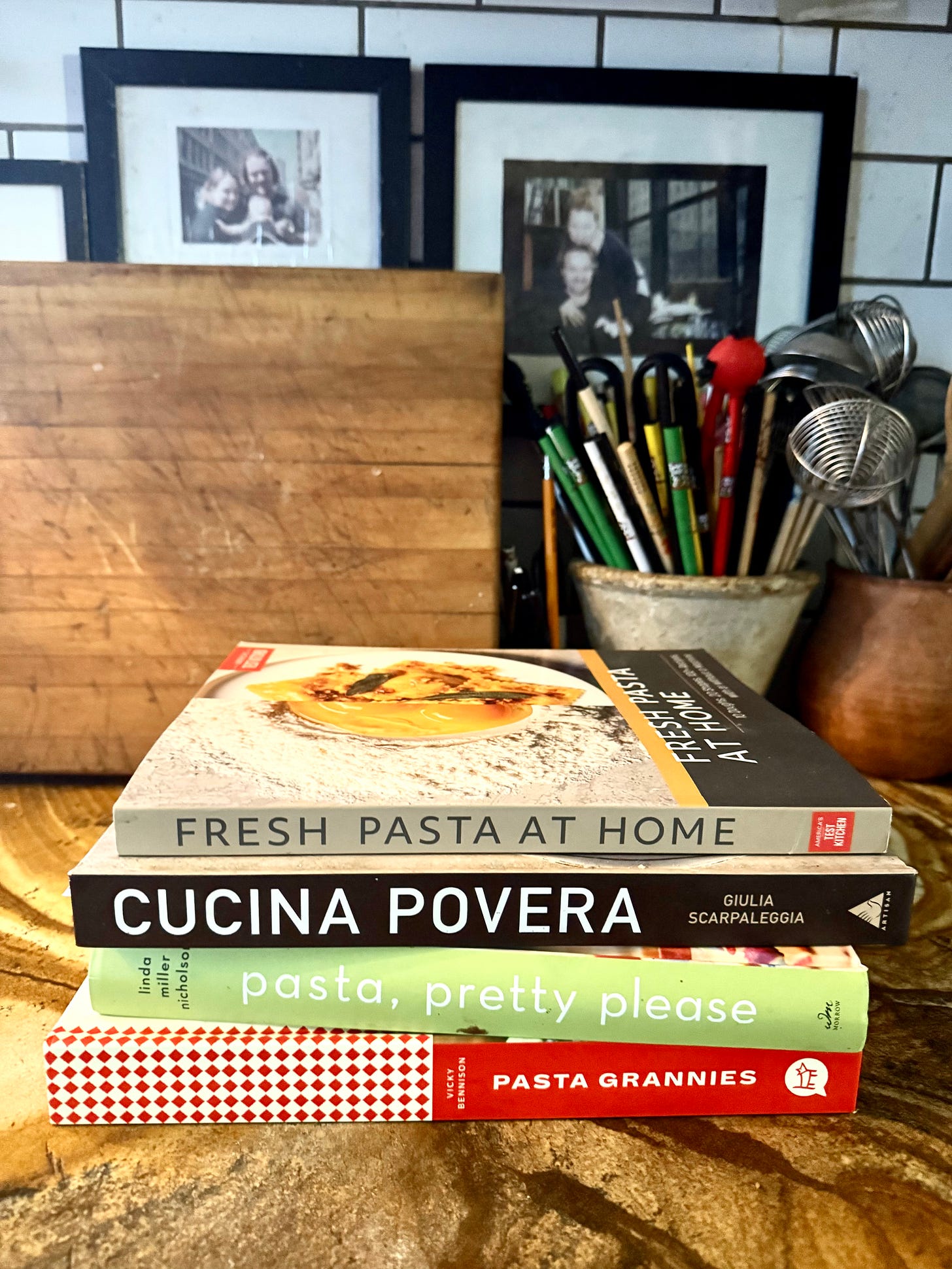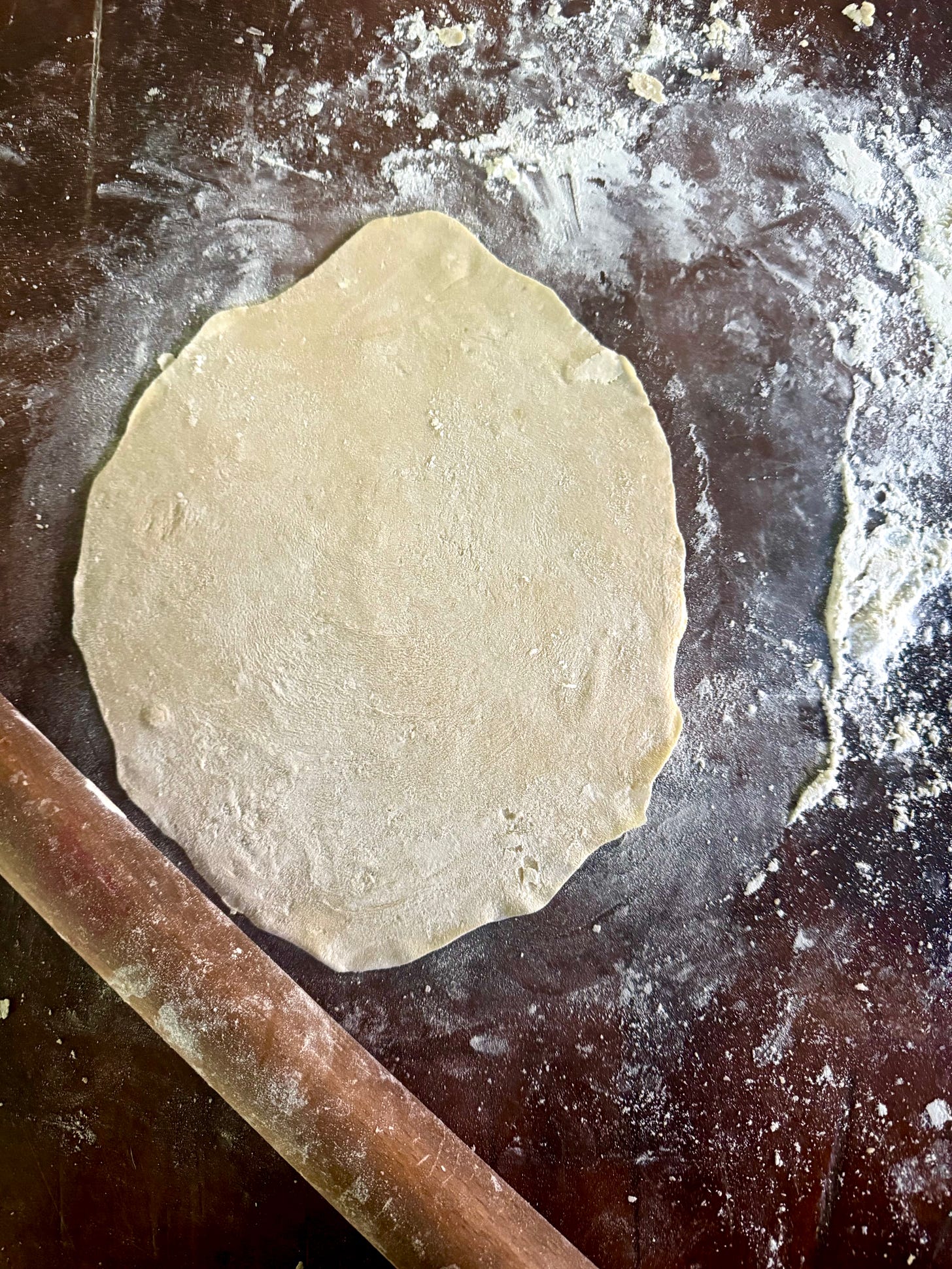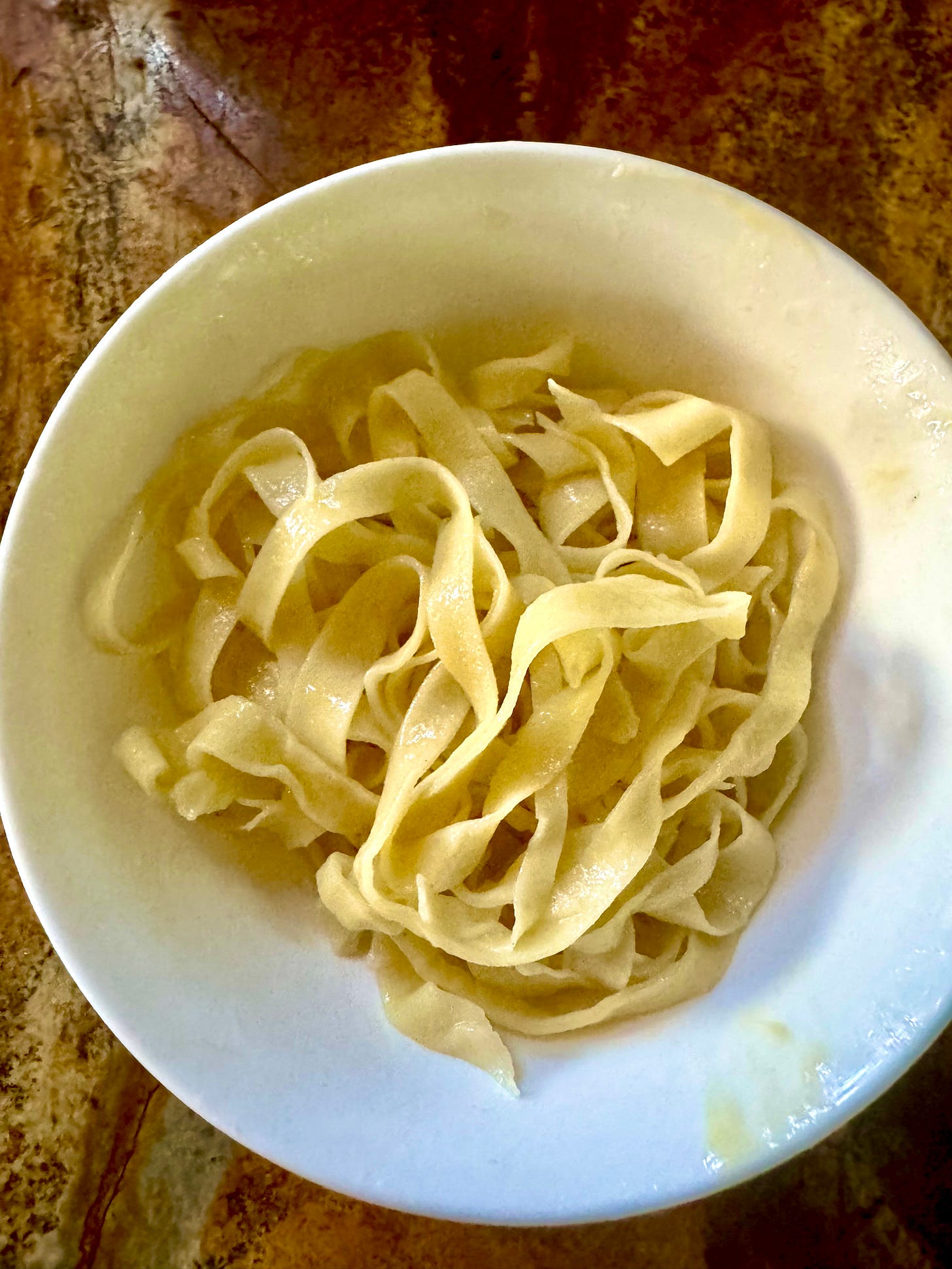Something about me has shifted in mid-life. Or maybe it’s Trump in office. Or the decline in my desire to be all in on social media. I am cantankerously in search of the opposite of these things. Things that quiet my mind. Keep my hands busy. Connect me to people. And also to the making of things.
And this has led me to pasta.
For the years that I’ve been cooking Ive been drawn to making Chinese food. Like the slow-braised red cooked pork belly that Kian Lam Kho taught me in his NYC apartment, which was across the hall from our apartment in Harlem. He took me to Chinatown shopping, we schlepped cloth bags filled with sauces and fish back on the A train. He explained ingredients to me, taught me sauces and techniques, like velveting, red cooking, and steaming.
He hosted multi-course Chinese meals on the special china he brought with him to the States and stored in the tub of his second bathroom - it was NYC after all. No space. My older kids grew up eating whole fried fish, vegetarian shark fin soup, and pork buns with radish greens. I met Grace Young through Kian, stopped using my wok as a planter (seriously) and started cooking fast and high. My stir-frying game got strong because of her.
Chinese cooking felt exciting, hot, fast, sweet and bitter, old and new simultaneously.
The kitchen would fill with smoke and David dismantled the smoke alarm so I could have free reign. I studied Kenji Lopez-Alt’s techniques in his excellent book The Wok, until I could achieve wok hei in some form on just about any cook surface.
There was always something I hadn’t tried, a dish I couldn't make, a history I didn’t know, a region I didn’t understand well-enough, a new-to-me product or ingredient that was a complete exciting mystery. I would grab the mystery product off the shelf and bring it home and research, experiment and taste and plod through Fuchsia Dunlop’s The Food of Sichuan, Every Grain of Rice and Land of Fish and Rice, as if they were biblical texts.
I replicated dishes and moved through the books, recipe to recipe, meal to meal, dinner party to dinner party. Still, to this day, a solid Chinese market makes me feel like I am inside the ultimate game. Always revelatory.
Chinese cooking is endless fun.
Lucy (20) and Edie (18), our older girls, grew up eating Chinese food at Kian’s house and then, through a creative osmosis into our own kitchen, they ate my Hong Kong noodles, home-made dumplings, whole fried fish, red-cooked pork belly in soft steamed buns with simple refrigerator pickles I make with nothing but an hour in the fridge dressed in sugar and salt.
And Chinese cooking was the gateway.
Upstate, at our country fixer-upper (not to be misconstrued with an actual country house) we went to a small Japanese restaurant there called Gomen Kudasai. The kids ate Sukiyaki Noodle bowls. Weekly. The owner and chef, Yoko allowed me to come into her kitchen after hours and she taught me how to make the soup. Somewhere in my files I documented it with my DSLR. The broth, she made, I remember, took days to make. An elaborate process.
So I went back to my kitchen and made it that way, too.
Sukiyaki is still comfort food for my oldest kids, the slightly sweet and earthy broth, thick, chewy udon noodles, tofu, slices of beef, some greens. The girls were little then. Yoko knew to bring two bowls, splitting one order for them and they would end up drinking the last drops from the bowl tipped into their mouths.
My cooking moved toward more Japanese techniques and ingredients after meeting Yoko, and later again, after visiting Tokyo, where we ate some of the best food of our life, in every hole in the wall noodle place, on every corner, because I’m not sure there is a bad or mediocre noodle shop anywhere in Japan.
We stuffed our faces with yakitori and started making Robata, as our own tradition, on Thanksgivings. I make Yoko’s karaage, once a week, little chunks of chicken thigh dusted in potato starch and deep fried, properly salted and MSG’d. Raffi’s favorite. Also tofu this way is good, too. Agadashi dofu, fried chunks of tofu in a puddle of umami made of dashi, soy sauce, mirin and ginger.
From there I moved to more cuisines. Weirdly, the food of Italy did not make me want to cook it. Eat it, yes. But I never felt drawn to make it my own.
Pasta was the thing you fed the kids, dried and store bought from the cupboard, smothered in cheese and butter. Or the thing you ate on Arthur Avenue in NYC with meatballs and gravy that some Nonna made. Or with theatre friends and big platters of pasta and red sauce on checkered table cloths at Carmine’s in Times Square.
Even in Naples, where we ate at small family-owned restaurants, that would inevitably end in us and strangers chatting at the table next to us, sharing wine and stories, children running around the tables in the cobble stone, graffiti-covered alleys, motor bikes whizzing past, too close for comfort, rustling our hair and clothes.
I wanted to eat it all. Partake in it all. But I wasn’t drawn to making or cooking pasta in the same way.
But now, I get it.
Pasta is simple, flour, eggs, oil, sometimes just flour and water. It can be made on a budget. With very little. The sauces can be simple and revelatory. Good olive oil and Parmesan, garlic, tomatoes, salt, herbs. I watched the Noodles sections of Chef’s Table, a show I often find a bit overly-precious and nauseating with all the tweezer food, but the LA Chef Evan Funke’s story and his mantra made an impression: #@&!YOURPASTAMACHINE.
Funke eschews sheeters. No machines!
This speaks to me in the way it spoke to me when Grace Young encouraged me to forgo getting a rice cooker and just learn to make rice perfectly by hand. I did and it has served me well. I can make a perfect pot of rice anywhere in almost any conditions.
This is the way to learn. To make it permanent in your brain.
I think in the past, I was fast in the kitchen. But I no longer want to be fast. I want to slow things down. I was too impatient to enjoy pasta making. How long do I have to knead this dough? Is it done yet? OMG, how many tortelli do I have to make to feed these people?
Now, I am seeking out things that slow me down, drive me to pay attention in the moment. It’s not entriely about the end product, but the process to get there.
David jokingly told me yesterday that I was the least zen person he knew and he isn’t wrong. I struggle to be still. My anxiety is always pushing me to the next thing. This is my way into some kind of zen. I’m in some kind of revolt against the internet which sometimes feels like loud poison, splattering me in the face. I want to use my hands. I want to feel the eggs matriculate into the flour. I want to feel the win of taking these disparate ingredients and turning them into something all their own with just my hands.
I have been watching Evan Funke on Youtube and also the Pasta Grannies. And these amazing super nerdy tutorials on how to roll out pasta dough with a matarello, a long wooden pasta roller. I am obsessed! The hand rolling, instead of using the machine, makes all these air pockets that make hand rolled and cut pasta super puffy and light. I’m not there yet. But I’m copying the way they use the roller. How specifically there are moves that get the best result, and the dough forms a translucent sheet around their roller. Almost like it is a textile.
When I started making pasta again, the noodles were just a tad too thick, too chewy. I hadn’t been patient. I wanted to get it down and move onto the next thing. But when I shifted my mind to just being in the moment with the rolling of the dough, everything changed. I could roll and roll until the dough was a thin translucent sheet, a filmy curtain.
I enjoyed the act for what it was. And the results changed.
I started to love the process, the meditative qualities. It reminded me of how much I enjoy making ratatouille by cutting the ever-so-thin slices of zucchini and tomato by hand, and not using a mandoline, which I don’t even own because I find them vicious and only for coordinated people. I found myself in my own little world, rolling, flipping it over repositioning to get it even. My arms moving in and out on the roller. I felt it all in my shoulders.
The cutting of the actual noodles brought the same quandry and solution. I pushed the dough onto a chitarra, so that the noodles were outlined. But then I removed the dough before there were cuts made and I cut the noodles with a knife. So satisfying, running that blade in straight lines over and over, the pasta puddling on the butcher block in long, imperfect strands.
I am relearning to cook fresh pasta, too. Fold fresh pata, stuff fresh pasta, sheet fresh pasta by hand. I am diving into new sauces and ideas to dress pasta. I am going back to Linda Miller Nicholson’s book, Pasta Pretty Please, using natural ingredients like spiralina, pea flower and cacao to make pasta into bright beautiful colors.
I love falling into something and getting some deep deep knowledge around it. Train my mind on things that make sense, that nurture my hands and my brain, and then that I can use these skills to feed and nurture people.
For David this is the whole purpose for this exercise: more opportunities to socialize, invite people over, bring people together, make pasta together, even. In the years since the pandemic cut our socializing (and specifically, our desire to socialize) we are getting back to it this year. With intention.
Pasta feels like the way to nurture the inside parts of me, and also bring people into the fold. Pasta is food my children will eat, even with all their food pecadillos. There will be more parties, more meals together, more bottles of wine opened and passed around (or non-alcoholic beer) more connections, more fullness, less focus on the world as it burns. More focus on the things that matter. The quieter, slower things.
Can pasta heal the world? Save us from oligarchies and madness andthe 24-hour news/panic cycle?
Probably not.
But it can it bring us joy? Calm? A sense of peeace? Can it make me a little saner? Can it bring people to the table together?
Yep. More of this, please. Whos’ in?














I used to have a big, year-round herb garden when I lived in Santa Monica. And I went through a phase of making fresh pasta, mixing finely minced fresh herbs into the dough. Your picky eaters might not like it, but when I served it to guests, simply sauced with good olive oil and Reggiano, their eyes would roll up into their heads. It was so good. And so light--I used to say that the pasta would levitate off the fork into the mouth. I did use a pasta machine, and it has been years since the last one I owned rusted out from disuse. And unfortunately, I now have to be on a low-carb diet for medical reasons. But I have delectable memories to savor. And you can try it-- colored vegetable powders mostly add color, not flavor. But fresh herbs provide color and flavor.
I'm mostly in. My 12-year-old grandson is completely in! He loves making pasta and is getting better with it. Mostly, he loves to eat it so this is his way of making it just the way he wants it. he and I spend our days together and when I'm not teaching him ELA, Math, Science and social studies -- we are cooking. I will mostly be watching him make it and supervising. I don't have the patience to make it -- but he does. This will be fun!